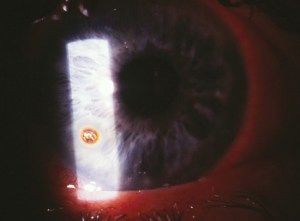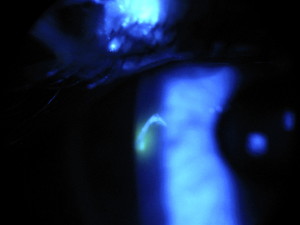 A friendly gentlemen came in to see me today with a very angry eye and reported that he had been working on his son’s car earlier in the week and his eye has been red and scratchy every since. As I was preparing to drill out the large hunk of rusted metal (left), it dawned on me, October is Eye Injury Prevention Month!
A friendly gentlemen came in to see me today with a very angry eye and reported that he had been working on his son’s car earlier in the week and his eye has been red and scratchy every since. As I was preparing to drill out the large hunk of rusted metal (left), it dawned on me, October is Eye Injury Prevention Month!
Statistically speaking, over 2.5 million Americans will experience an eye injury this year. Some injuries are simply unavoidable or arise from falls or motor vehicle accidents, most injuries occur due to negligence and a lack of proper protective eye wear.
It is a common misperception that all eye injuries occur “on the job.” In reality, about 45% of eye injuries actually occur at home and (I’m sorry guys) men have much higher risk for eye injuries than women.
Common places/tasks for Eye Injury
-
Yardwork
Mowing the lawn or being outside while others are mowing. This is doubly true for power edging or using gas or electric powered trimmers. Rocks, organic debris, and dirt can be picked up and propelled with dangerous speed by all of these machines and tools.
-
 Workshop
WorkshopAs a carpenter I can assure you, the force with which a power tool expels projectiles can be simply staggering (picture right is a deep corneal laceration from metal lathe work). Think about the work that needs to be accomplished and which tools you will be utilizing and plan accordingly. Also consider what chemicals/stains/sprays/fumes your eyes may come in contact with.
-
Working on the car
There’s more at risk here than just a bruised knuckle. Working on and especially under a car is a major source of metallic foreign bodies. Additionally, arcs, sparks, and battery acid can be blinding. Keep protective goggles in your garage and vehicle and wear them for any and all repairs.
-
Housework
If you actually read the ingredients of most household cleaners, you may be surprised. Make sure these dangerous chemicals, cleaners, and disinfectants are used in a well-ventilated area and with proper eye protection. Chemical splashes from some of these hazardous cleaners can cause permanent burns and vision loss.
In order to combat these potentially blinding situations, we strongly recommend that all households have at least one pair of ANSI-approved safety glasses to use for these tasks to reduce the chance of eye injury. In order for glasses to be marketed for safety purposes the lens and/or frame must bear the required marking of ANSI Z87 or preferably Z87+ (the ‘+’ denotes high impact resistance). Protective eyewear of this kind is readily available at all hardware stores or purchased from your local eye doctor. It is important that safety glasses fit close to the face with minimal gaps for optimum protection against chemical splashes. Click here for additional information on safety eye wear.
If a chemical splash does occur, rinse the eye with copious amounts of luke-warm tap water for 15 minutes. That may seem like a long time but this is imperative. The sooner this gets done the better, as this will dilute and neutralize the caustic compounds. Then seek treatment from your local eye care provider.
The cornea is extremely sensitive and has more nerve endings than any other tissue in the body. Anyone who’s had an eye injury can tell you; they hurt… A LOT!
Accidents happen, but Ben Franklin said it best, “an ounce of prevention is worth a pound of cure.”
We hope you have enjoyed this quick talk on eye injury prevention. If you have any additional questions or think of a topic for future discussion; drop me a line at [email protected].
Wear your safety glasses and take care of those eyeballs!


